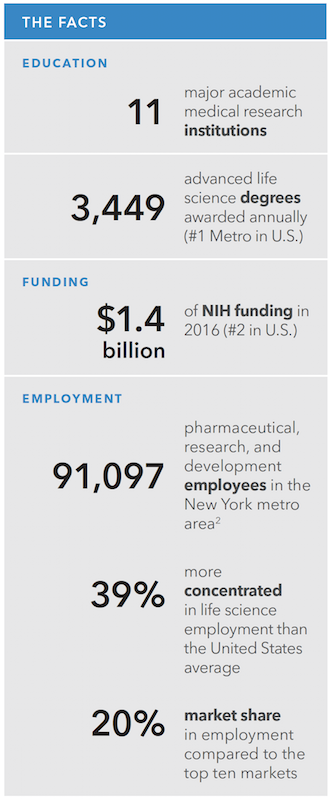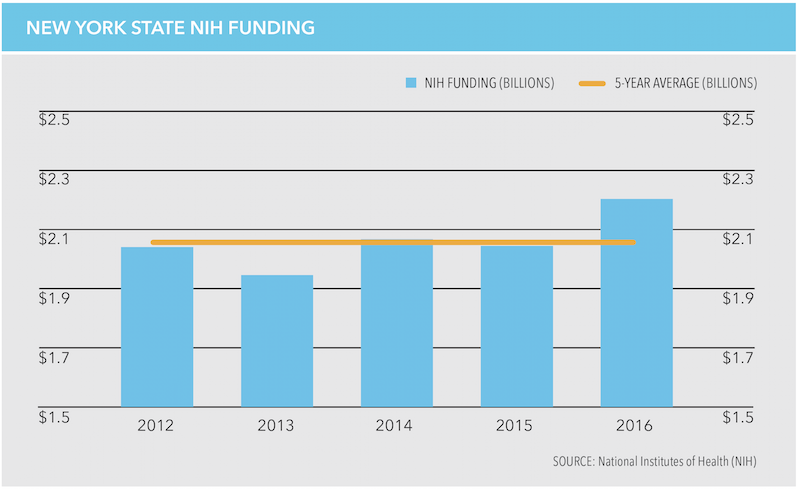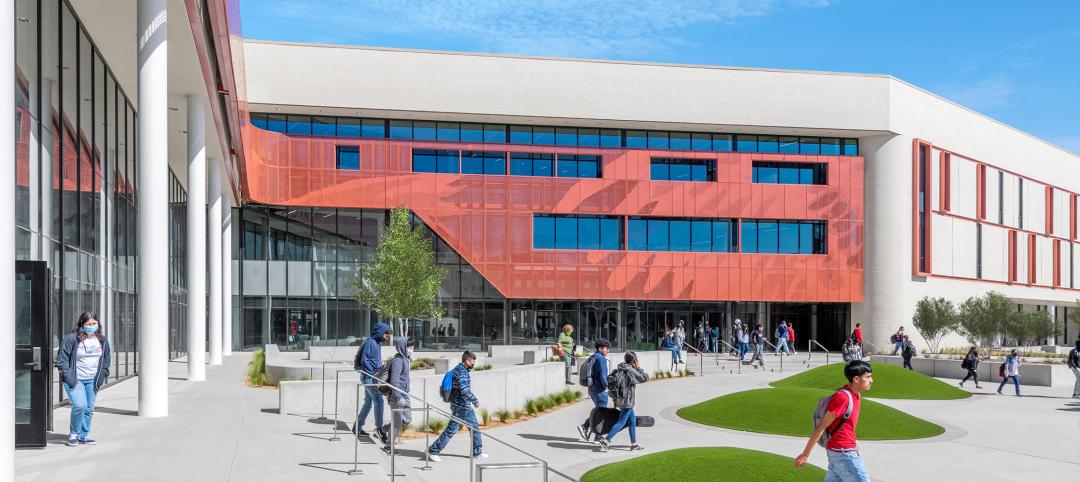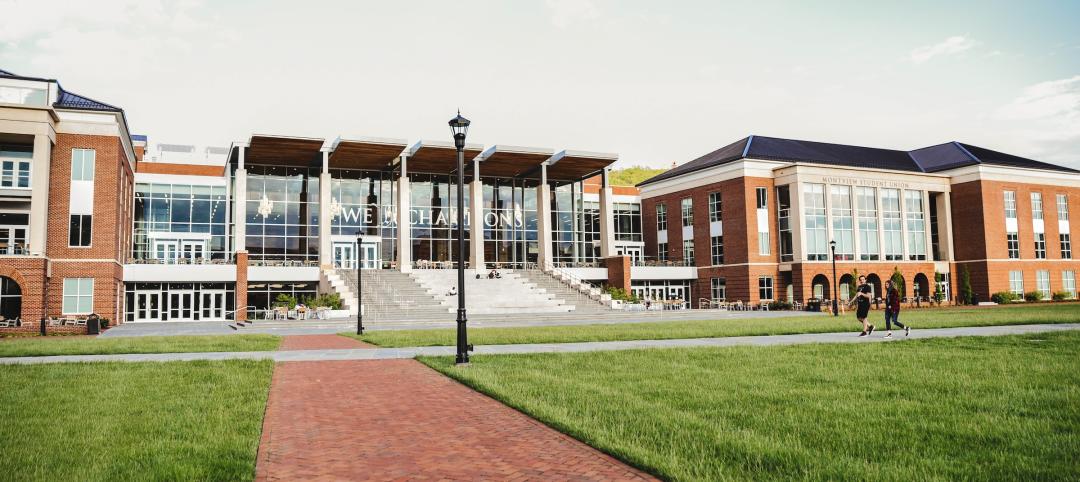Developers Taconic Investment Partners and Silverstein Properties are spending $20 million to renovate the 326,861-sf Movie Lab building in Midtown Manhattan for life science research usage.
The New York Post reports that the Stem Cell Foundation has leased 42,100 sf in this building since 2015. Another 150,000 sf on the top floors of this 10-story building are being upgraded to attract more life science tenants. The building reportedly is changing its name to the Hudson Research Center.
Transwestern, which is marketing this lab space for the developers, has released a special report that portrays New York City as an emerging life sciences hub, where space is tight and development opportunities are multiplying.
New York is already a significant player in this field, by virtue of being home to 11 major academic medical centers, including Weill Cornell Medical College and Albert Einstein College of Medicine. The city also has three of the country’s top 15 hospitals and five of the top 50 medical schools, according to U.S. News and World Report’s latest report card.

New York City is already a leader in life sciences employment and, more recently, available funding. Image: Transwestern
The city also one of the country’s highest concentrations of life-science employees, accounting for one-fifth of the total employment in this sector within the top 10 life science markets.
The problem is shortage of lab space. Transwestern estimates that 100% of the city’s 1.7 million sf of existing life science and research space is occupied. And until recently, New York’s zoning restrictions made it particularly tough for life science companies to build lab space within manufacturing districts—M Zones—that restrict chemical compounding and packaging, the creation of pharmaceutical products and medical appliances, laboratories, research, experimental and testing facilities.
But over the past year or so, market and regulatory changes have made development more conducive for lab science expansion.
Indeed, recent lease transactions have included 49,143 sf at 10 Hudson Yards for Intercept Pharmaceuticals, 30,000 sf at 101 Avenue of the Americas for JLABS (division of J&J Innovations), 19,645 sf at 100 Wall Street for Integra Partners, 11,865 sf at 600 Third Avenue for Turing Pharmaceuticals, and 11,537 sf at 25 West 45th Street for Crossover Health.
More investment capital and funding are flowing into the city for this sector. Out of the $31.3 billion in National Institutes of Health funding awarded nationally in 2016, the New York metro area received $2.7 billion in NIH grants. New York City alone was awarded $1.4 billion, ranking it the second-highest funded city in the country.

More dollars from the National Institutes of Health are flowing into New York State and, particularly, New York City. Image: NIH/Transwestern
Last December, New York Governor Andrew Cuomo unveiled a state-funded life science initiative that includes $250 million in tax incentives for new and existing life science companies, $200 million in state capital grants to further support investment in wet-lab and innovation space, $100 million in investment capital for early stage life science initiatives, and a state match of at least $100 million for operating support from private sector partnerships.
New York City Mayor Bill DiBlasio also has launched a program called LifeSci NYC, which will include a $100 million investment to create a new applied life science campus, $50 million to expand a network of life science R&D facilities, $10 million to expand the network of incubators, $20 million a year in matching funds to support early-stage businesses, and $300 million in tax incentives for commercial lab space.
On the zoning front, in December the Departments of Buildings (DOB) and City Planning (DCP), and the Economic Development Corporation (EDC) issued a clarification memo updating their interpretation of the zoning in the several commercial districts.
The city agencies and the EDC, says Transwestern, “broadened their understanding of the current use group 9A zoning to also include the “synthesis and manipulation of chemical substances, biological matter, and animal models … [that] are integral activities in commercial medical laboratories devoted to research and testing.”
Already, new research and lab spaces are popping up. The Cornell Tech campus on New York City’s Roosevelt Island just opened its first phase. And the 1.17-million-sf Building 77 at the Brooklyn Navy Yard is undergoing a $185 million renovation that could attract lab tenants.
Related Stories
Education Facilities | Nov 9, 2023
Oakland schools’ central kitchen cooks up lessons along with 30,000 meals daily
CAW Architects recently completed a facility for the Oakland, Calif., school district that feeds students and teaches them how to grow, harvest, and cook produce grown onsite. The production kitchen at the Unified School District Central Kitchen, Instructional Farm, and Education Center, (“The Center”) prepares and distributes about 30,000 meals a day for district schools lacking their own kitchens.
Giants 400 | Oct 30, 2023
Top 170 K-12 School Architecture Firms for 2023
PBK Architects, Huckabee, DLR Group, VLK Architects, and Stantec top BD+C's ranking of the nation's largest K-12 school building architecture and architecture/engineering (AE) firms for 2023, as reported in Building Design+Construction's 2023 Giants 400 Report.
Giants 400 | Oct 30, 2023
Top 100 K-12 School Construction Firms for 2023
CORE Construction, Gilbane, Balfour Beatty, Skanska USA, and Adolfson & Peterson top BD+C's ranking of the nation's largest K-12 school building contractors and construction management (CM) firms for 2023, as reported in Building Design+Construction's 2023 Giants 400 Report.
Giants 400 | Oct 30, 2023
Top 80 K-12 School Engineering Firms for 2023
AECOM, CMTA, Jacobs, WSP, and IMEG head BD+C's ranking of the nation's largest K-12 school building engineering and engineering/architecture (EA) firms for 2023, as reported in Building Design+Construction's 2023 Giants 400 Report.
Higher Education | Oct 10, 2023
Tracking the carbon footprint of higher education campuses in the era of online learning
With more effective use of their facilities, streamlining of administration, and thoughtful adoption of high-quality online learning, colleges and universities can raise enrollment by at least 30%, reducing their carbon footprint per student by 11% and lowering their cost per student by 15% with the same level of instruction and better student support.
Giants 400 | Sep 28, 2023
Top 80 University Building Engineering Firms for 2023
AECOM, Jacobs, BR+A, and Salas O'Brien head BD+C's ranking of the nation's largest university sector engineering and engineering/architecture (EA) firms for 2023, as reported in Building Design+Construction's 2023 Giants 400 Report. Note: This ranking includes revenue for all university/college-related buildings except student residence halls, sports/recreation facilities, laboratories, S+T-related buildings, parking facilities, and performing arts centers (revenue for those buildings are reported in their respective Giants 400 ranking).
Giants 400 | Sep 28, 2023
Top 100 University Building Construction Firms for 2023
Turner Construction, Whiting-Turner Contracting Co., STO Building Group, Suffolk Construction, and Skanska USA top BD+C's ranking of the nation's largest university sector contractors and construction management firms for 2023, as reported in Building Design+Construction's 2023 Giants 400 Report. Note: This ranking includes revenue for all university/college-related buildings except student residence halls, sports/recreation facilities, laboratories, S+T-related buildings, parking facilities, and performing arts centers (revenue for those buildings are reported in their respective Giants 400 ranking).
University Buildings | Sep 27, 2023
Top 170 University Building Architecture Firms for 2023
Gensler, CannonDesign, Page Southerland Page, SmithGroup, and Ayers Saint Gross top the ranking of the nation's largest university sector architecture and architecture/engineering (AE) firms, as reported in Building Design+Construction's 2023 Giants 400 Report.
K-12 Schools | Sep 5, 2023
CHPS launches program to develop best practices for K-12 school modernizations
The non-profit Collaborative for High Performance Schools (CHPS) recently launched an effort to develop industry-backed best practices for school modernization projects. The Minor Renovations Program aims to fill a void of guiding criteria for school districts to use to ensure improvements meet a high-performance threshold.
Giants 400 | Aug 22, 2023
Top 115 Architecture Engineering Firms for 2023
Stantec, HDR, Page, HOK, and Arcadis North America top the rankings of the nation's largest architecture engineering (AE) firms for nonresidential building and multifamily housing work, as reported in Building Design+Construction's 2023 Giants 400 Report.

















